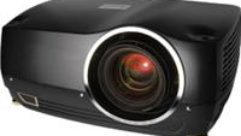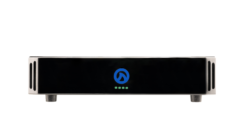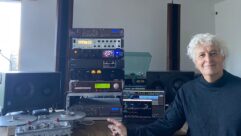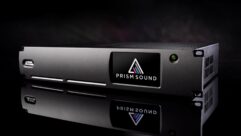SCAN CONVERSION: getting there is half the fun
Dec 1, 1998 12:00 PM,
Peter H. Putman
You have no doubt seen plenty of advertisements for the latest inboardroom-quality LCD projection systems. Many models offer a potentcombination of high brightness and high resolution, albeit at a price. Theymake for an attractive purchase if you are upgrading an older facility ordoing a new install, but where does that leave any older display monitorsor projectors your customer already has in place? Bear in mind that in thedisplay business, “older” may mean only two years or so. Can you recycleany of this used equipment? What about that high-brightness VGA or SVGAprojector for which your client plunked down nearly $10,000 in 1996?
In an age of dizzying technological advances, one of the biggest fears ourclients express is of rapid obsolescence. It is bad enough that theircomputer systems are continually overtaken by faster, more powerful models.Although most clients have learned to live with that fact, A-V equipment isanother story altogether.
You may be able to save the day and make a more palatable short-termupgrade by using a scan converter to downconvert high-resolution images tothose existing video/VGA projectors and monitors. Scan conversion isdefinitely a compromise, but in many cases, you will be doing yourlarge-screen display a big favor and will probably wind up withbetter-than-expected image quality.
Traditionally, scan conversion has been associated with dropping computerworkstation images down in resolution to be displayed on standard 15.75 kHzcomposite video monitors. It has always been a quick and dirty way tovideotape PowerPoint shows, animations and graphics, but there are plentyof applications for scan converters beyond these mundane tasks.
For starters, many generic boardroom/classroom CRT projectors use 7 inch(178 mm) tubes, which are happiest displaying images with no more than 500to 600 vertical picture lines. Plenty of them were installed to view videoand VGA (640 x 480) computer graphics, but they cannot work above thatpoint without decreased brightness. Some 7 inch models accept scan rates ashigh as 64 kHz, but that is really 8 inch (203 mm) CRT territory.
If a new higher-resolution projector is not in the budget, a scan convertercan downconvert any high-resolution image to 640 x 480 or even 800 x 600,allowing the existing CRT projector to run at its optimum beam current andbrightness settings. Granted, there will be some loss of detail, dependingon the quality of the scan converter and the input resolution. You will,however, be able to maintain optimum image brightness and contrast settingsfor that particular projector.
The same holds true for older single-panel amorphous LCD and three-panelpolysilicon LCD projectors, many of which have plenty of life left in them.While the downconversion process will result in some pixel decimation andloss of detail, the results may be acceptable for most users. This isparticularly true when viewing Web pages, most of which are still optimizedfor 640 x 480 displays.
Presentation monitors also suffer from loss of detail when trying todisplay high-resolution images. Just because the monitor may accept 1,024 x768 or even 1,280 x 1,024 scan rates does not mean you will see all thatdetail on the screen. The culprit is dot pitch. On a standard desktopcomputer monitor, the CRTs used can resolve dots as small as 0.25 mm to0.28 mm. With this resolution, you can clearly display 1,024 x 768 imageson a 19 inch (483 mm) monitor.
Simple math would indicate we need a dot pitch no coarser than about 0.4 mmto accomplish the same thing on a 27 inch (686 mm) presentation monitor.Yet, the standard dot pitch for many years in this size picture tube was0.75 mm, nearly three times as coarse. Even the new 29 inch (737 mm)multimedia monitors can achieve only 0.6 mm center dot pitch. For a 37 inch(940 mm) monitor, the optimal dot pitch would be 0.54 mm, but it is reallymore like 0.75 mm to 0.8 mm, which is not crisp enough to show truehigh-resolution images.
These mathematical boundaries are not entirely lost on displaymanufacturers. At least one of them introduced a presentation monitoroptimized for video/VGA with space for a plug-in scan converter todownconvert higher computer resolutions. I once ran a side-by-side testbetween Sony’s PGM-200R1U and NEC’s MultiSync XM29 with 1,024 x 768 images,and the image quality was comparable whether scan converted on the Sony ordisplayed native on the NEC.
There is, of course, a catch. You must use a scan converter of sufficientquality; otherwise, you are better off buying a new monitor or projector.Fortunately, there are models available that will jump through hoops andprovide both video and 640 x 480 downcon-verted output. There are alsohigher-priced models from RGB Spectrum and Folsom Research that will evendown-convert to 800 x 600 resolution.
Have a client nagging you to install a plasma display? Be advised that PDPswork well only at their native resolution. The current crop of 40 inch (1m) 4:3 and 42 inch (1.1 m) 16:9 plasma panels are all essentially VGAdevices with 480 vertical lines of pixels. Only half the models availablecan handle SVGA, and forget XGA; it is unreadable. One model will not syncup to anything higher than 31.5 kHz signals.
If you need to pump high-resolution images through a plasma panel, tryusing a good scan converter ahead of it. Do not scrimp; you are going todrop about $8,000 to $12,000 on a 40 inch (1 m) plasma panel anyway, soadding a $3,000 to $6,000 scan converter is a wise investment. Point out toyour client that the next highest resolution panels available (50 inch or1.3 m at 1,280 x 786) are currently retailing for around $25,000.
Sony has also gone the built-in scan conversion route with its newPFM-500A1WU 42 inch (1.1 m) plasma display based on the Fujitsu chassis. Itincorporates Sony’s DSC 1024 for downconverting any computer signals with amaximum horizontal scan rate of 85 kHz to 640 x 480 resolution.
Your investment in a scan converter will come in handy in other ways, mostnotably in that unholy marriage between computer graphics displays andvideoconferencing. Videocon-ferencing codecs are basically limited toprocessing composite and S-Video signals over everything from LANs totelephone lines, fiber optics, cable and satellite links. Whatever thetransmission mode, the signals required are still baseband video. That cancause plenty of headaches when a conference participant wants to tie inhis/her notebook or desktop computer to show a spreadsheet. The answer, ofcourse, is to decrease resolution, treating the computer’s video card likeany other NTSC camera or VTR. Many scan converters are specificallytargeting this market, accepting everything from VGA to XGA (even includinga few oddball Mac scan rates) and offering digital zoom and pan controls.
The quality of the digital zoom and pan generally varies with price-thehigher you go, the wider the zoom and pan range. Broadcast studio-qualityscan converters, such as those made by RGB Spectrum (VideoLink 1700 series)and Folsom Research (9700 XL), can zoom signals from 50% to as much as 400%of the original image. These scan converters will also provide a greaterrange of horizontal and vertical flicker filter settings.
Scan converters work well with in-house video networks and automatedservers, particularly with RF-modulated transmissions. Any source materialcan be brought into the network, especially graphics and other imagescreated on specialized workstations. File format compatibility is never anissue when the end result is standard video. Many newer scan convertersoffer serial digital video output connections for even cleaner signals.
In short, scan converters are pretty handy products to have around. Theircosts have come down considerably in the past five years, so much so thatit might be advisable just to add one to your next upgrade or retroinstallation just in case your client later decides he needs any of theapplications mentioned previously.










